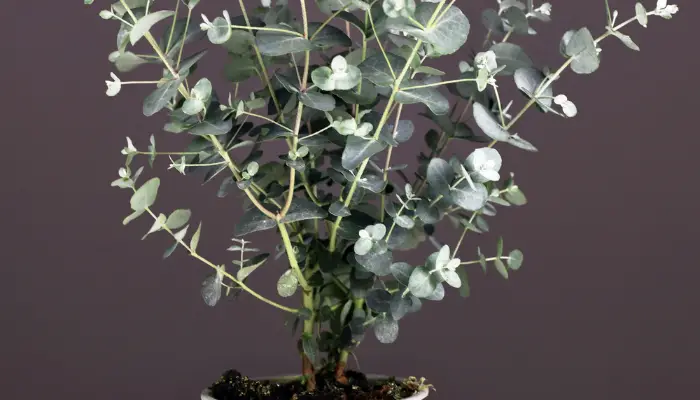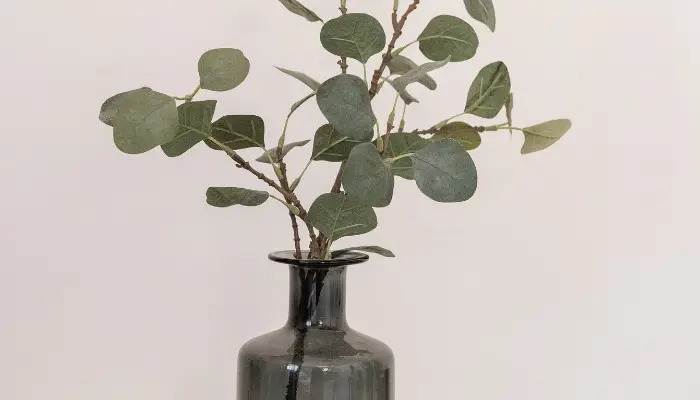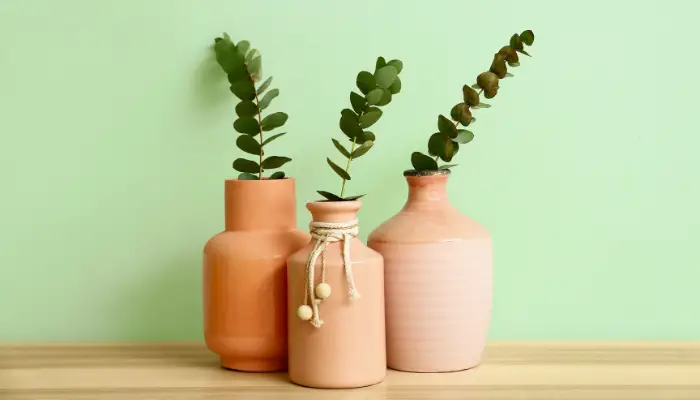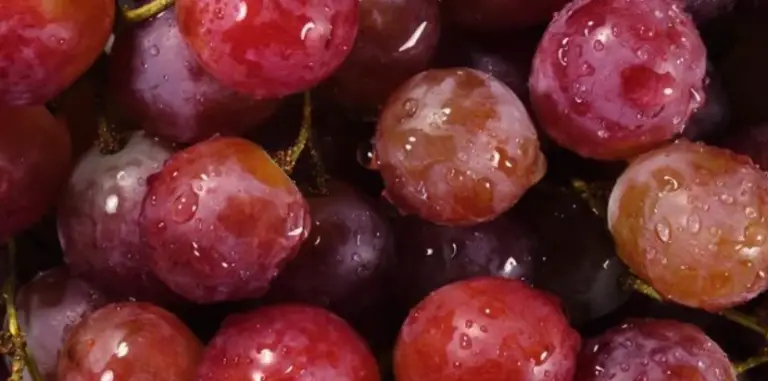How to Grow Eucalyptus in Pots and Care For It
Growing eucalyptus in pots is a great way to enjoy the beauty and fragrance of these evergreen trees. Eucalyptus plants are native to Australia but can be grown in many climates as long as they have enough light, water, and drainage. Here are some tips on how to grow and care for eucalyptus in pots.

Choose the Right Species
Some eucalyptus species grow very large and fast, which is not ideal for pot cultivation. Look for dwarf or compact varieties, such as Eucalyptus Gunnii ‘Azura’, and Eucalyptus pauciflora. Niphophila ‘Mount Bogong’, or Eucalyptus archery. These species have smaller, rounder, and more silvery leaves that are attractive and aromatic.
Select the Right Pot
Eucalyptus plants have a strong root system that needs plenty of space and air circulation. Use a large pot with drainage holes and a high rim to prevent tipping over. You can also use an air pot, which is a special container that prunes the roots and encourages new growth. Place your pot in a sunny spot that receives at least six hours of direct sunlight per day.
Use a Well-Draining Potting Mix
Eucalyptus plants do not like wet or soggy soil, which can cause root rot and fungal diseases. Use a high-quality potting mix that contains perlite, vermiculite, or sand to improve drainage. You can also add some organic matter, such as compost or peat moss, to enrich the soil and retain moisture.
Water and Fertilize Regularly
Eucalyptus plants need consistent watering during the growing season, especially in hot and dry weather. Check the soil moisture frequently, and water thoroughly when the top inch feels dry. Do not let the soil dry out completely or become waterlogged. Once a week, add a liquid fertilizer to your watering can and feed your plant with a low-nitrogen formula. This will promote healthy foliage and prevent excessive growth.
Prune and Shape Your Plant
Eucalyptus plants can grow quickly and become leggy or unruly. To keep your plant compact and bushy, prune it lightly in late spring or early summer. Remove any dead, damaged, or diseased branches, and cut back any stems that are too long or out of shape. You can also train your plant as a standard or a multistem, which will give it more stability and interest. To do this, select a main stem or several stems and remove the lower branches. Tie the stem(s) to a stake or a trellis and let them grow vertically. Prune the top and the sides to form a ball or a dome shape.
Harvest and Enjoy Your Plant.
Eucalyptus plants are not only ornamental but also useful. You can harvest the leaves and branches for various purposes, such as making wreaths, bouquets, potpourri, or tea. The best time to harvest is in late summer or early fall when the leaves are mature and fragrant. Cut the stems with a sharp knife or scissors and strip off the lower leaves. You can use them fresh or dry them for later use. To dry them, spread them on a paper towel or a drying screen and place them in a cool, dark, and well-ventilated area. When the leaves are crisp, store them in a glass jar with a tight lid.
Eucalyptus plants are easy to grow and care for in pots, as long as you follow some basic guidelines. They will reward you with their stunning foliage, pleasant scent, and versatile uses. Try growing eucalyptus in pots and enjoy the benefits of this amazing plant.
How to Propagate Eucalyptus from Cuttings?
Propagating eucalyptus from cuttings is possible, but it requires some care and attention. Here are the main steps you need to follow:
- Take healthy cuttings from a mature eucalyptus tree, preferably in late spring or early summer. The cuttings should be about 4 to 6 inches long, with at least two pairs of leaves.
- Remove the lower leaves and dip the cut ends in a rooting hormone, such as powder or gel. This will help the cuttings form roots faster and prevent them from rotting.
- Plant the cuttings in small pots filled with a well-draining potting mix, such as perlite, vermiculite, or sand. Insert the cuttings about 2 inches deep and firm up the soil around them.
- Cover the pots with clear plastic bags or domes to create a humid environment for the cuttings. Place the pots in a warm and bright spot, out of direct sunlight. A heat mat can help maintain a consistent temperature of about 70°F.
- Water the cuttings regularly, but not too much. The soil should be moist, but not soggy. You can mist the cuttings occasionally to keep the humidity high.
- Check the cuttings for root development after 4 to 6 weeks. You can gently tug on the cuttings to see if they resist. If they do, it means they have rooted. You can also remove the plastic cover and look for roots at the bottom of the pots.
- Once the cuttings have rooted, you can transplant them to larger pots or the ground, depending on your climate and preference. You can also remove some of the plastic cover to acclimate the cuttings to the ambient air gradually.
What is the Best Time to Take Cuttings?

The best time to take cuttings from a eucalyptus tree is in late spring or early summer when the tree is actively growing and the stems are tender and flexible. This will increase the chances of successful rooting and establishment. Avoid taking cuttings in winter, when the tree is dormant and the stems are hard and woody. This will reduce the chances of rooting and increase the risk of rotting.
Using the Misting System to Propagate Eucalyptus?
A misting system is a device that sprays a fine mist of water over the cuttings and the rooting medium to keep them moist and humid. Misting systems can be beneficial for propagating eucalyptus, as they can reduce the transpiration and stress of the cuttings and promote faster and more reliable root development. However, misting systems also have some drawbacks, such as increasing the risk of fungal diseases, requiring more maintenance and monitoring, and being more expensive than other methods. Therefore, if you decide to use a misting system to propagate eucalyptus, you should also take some precautions, such as:
- Use clean and sterile equipment and materials, and disinfect them regularly.
- Use a well-draining and aerated rooting medium, such as perlite, vermiculite, or sand, to prevent waterlogging and rotting.
- Adjust the frequency and duration of the misting according to the temperature, humidity, and light conditions, and avoid overwatering or underwatering the cuttings.
- Provide adequate ventilation and air circulation around the cuttings, and remove any dead or diseased material promptly.
- Monitor the cuttings for signs of rooting, and gradually reduce the misting as they become established.
How do I disinfect my equipment and materials?
To disinfect your equipment and materials for plant propagation, you need to first clean them well to remove any dirt, debris, and plant residue. Then, you can use one of the following methods to disinfect them:
- Use a household cleaner, such as Lysol or Simple Green D, and soak the equipment and materials in it for a few minutes. You can also dilute the cleaner with water to make it less corrosive
- Use disinfectant wipes, such as Lysol or Clorox wipes, and wipe the equipment and materials thoroughly. You may need to use more than one wipe per item.
- Use steam or dry heat, and heat the equipment and materials to 180°–200° F (82°–93° C) for about 30 minutes. You can use a steam basket, an oven, or a microwave for this method.
- Use 70% isopropyl alcohol, and dip the equipment and materials in it for a few seconds. Then, let them air dry.
- Use bleach, and mix one part bleach with nine parts water. Dip the equipment and materials in the solution for a few minutes, then rinse them with clean water.
- Make sure to follow the label instructions of any disinfectant you use, and wear gloves and eye protection when handling them. Also, avoid mixing different disinfectants, as this can create harmful fumes or reactions. For more information and tips on how to disinfect your equipment and materials, you can check out these sources: How to Disinfect Tools and Equipment, Sanitation is critical to preventing plant diseases. I hope this helps you keep your plants healthy and disease-free. Happy gardening!
Common Plant Diseases that Can Be Prevented by Disinfection?

Some common plant diseases that can be prevented by disinfection are:
- Powdery mildew, which causes a white, dusty coating on leaves, stems, and flowers. It affects many plants, such as lilacs, apples, grapes, cucumbers, peas, phlox, daisies, and roses.
- Downy mildew, which causes the upper portion of leaves to discolor while the bottoms develop white or gray mold,. It affects many plants, such as impatiens, pansies, columbine, grapevines, lettuce, and cole crops.
- Black spot, which causes small black spots on foliage, which starts to turn yellow and eventually drops off. It affects mainly roses, but also other flowers and fruits.
- Mosaic virus, which causes mottled yellow and green leaves that are sometimes curled and distorted. It affects many plants, such as tomatoes, peppers, potatoes, apples, pears, cherries, cucumbers, lettuce, beets, petunias, and tobacco.
Disinfection can help prevent these diseases by killing or reducing the pathogens that cause them. Disinfection can be done by using household cleaners, disinfectant wipes, steam, dry heat, alcohol, or bleach to sanitize the tools, equipment, and materials used for plant propagation and maintenance.
How do I recognize plant diseases?
There are many different types of plant diseases, and they can affect different parts of the plant, such as leaves, stems, roots, flowers, or fruits. Some common signs and symptoms of plant diseases are:
- Discoloration: The plant may show yellow, brown, black, or other colors that are not normal for its species or variety. For example, powdery mildew causes white patches on leaves, while black spots cause black spots on roses.
- Deformation: The plant may have distorted, curled, wilted, or stunted growth. For example, mosaic virus causes mottled and twisted leaves on tomatoes, while stem rot causes the stem to collapse and decay.
- Lesions: The plant may have spots, blisters, cankers, or holes on its surface. For example, leaf spots cause brown or black spots on leaves, while anthracnose causes sunken lesions on fruits.
- Mold: The plant may have fuzzy, cottony, or slimy growth on its surface or inside its tissues. For example, downy mildew causes gray mold on the underside of leaves, while botrytis causes gray mold on flowers and fruits.
- Decay: The plant may have soft, mushy, or rotten parts that smell bad. For example, root rot causes the roots to turn brown and mushy, while fruit rot causes the fruits to turn black and soft.
How do you Prevent plant diseases?
There are many ways to prevent plant diseases in your garden, such as choosing the right plants for your site, keeping them healthy and well-watered, removing infected or dead plant parts, and using proper sanitation and pest control methods. Here are some general tips to prevent plant diseases:
- Choose plants that are suited for your climate, soil, and sun exposure. You can also look for disease-resistant varieties of your favorite plants, which are less likely to get infected by common pathogens. For example, some roses are resistant to black spot, some tomatoes are resistant to blight, and some apples are resistant to scab.
- Keep your plants healthy and stress-free by providing them with adequate water, fertilizer, and mulch. Water your plants deeply and regularly, but avoid overwatering or watering the foliage, which can promote fungal growth. Fertilize your plants according to their needs, but do not overdo it, as excess nitrogen can make plants more susceptible to diseases. Mulch your plants with organic materials, such as leaves, straw, or wood chips, to conserve moisture, suppress weeds, and moderate soil temperature
- Remove any infected or dead plant parts as soon as you notice them and dispose of them properly. Do not compost or reuse any diseased plant material, as this can spread the infection to other plants. Prune any damaged, diseased, or dead branches from your trees and shrubs, and cut off any wilted, spotted, or yellowed leaves from your flowers and vegetables. This will help prevent the spread of pathogens and improve the appearance and health of your plants.
- Clean and sanitize your tools, pots, and containers before and after using them. You can use household cleaners, disinfectant wipes, alcohol, bleach, or heat to kill any pathogens that may be present on your equipment. This will help prevent cross-contamination and the introduction of new diseases to your garden.
- Control pests and weeds that can harbor or transmit diseases to your plants. You can use physical, biological, or chemical methods to manage pests and weeds, depending on the severity and type of the problem. For example, you can use traps, barriers, or handpicking to remove insects, slugs, or snails. You can use beneficial insects, such as ladybugs, lacewings, or parasitic wasps, to control aphids, whiteflies, or caterpillars. You can use organic or synthetic pesticides, such as insecticidal soap, neem oil, or pyrethrin, to kill or repel pests. You can use hoeing, pulling, or mulching to control weeds. You can also use pre-emergent or post-emergent herbicides, such as corn gluten, glyphosate, or vinegar, to kill or prevent weeds.








